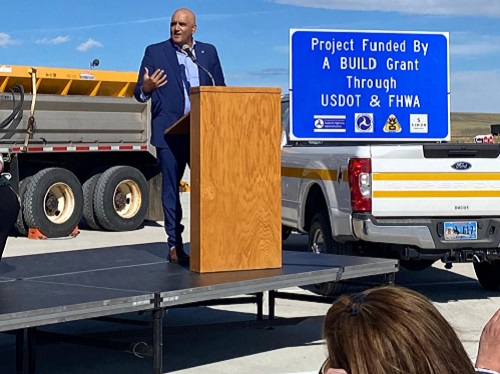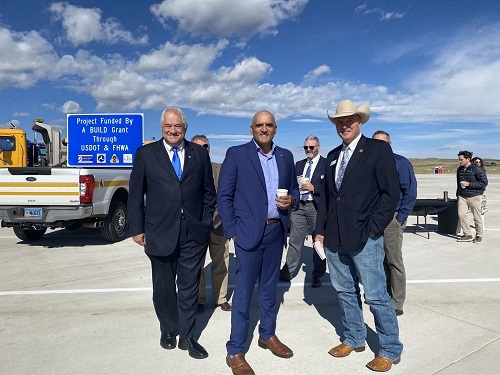The Federal Highway Administrator recently showed off 200 new truck parking spaces along I-80 outside Laramie, WY, that will help provide safer stopping areas for freight carriers, especially during winter storms.
[Above photo by the FHWA]
The agency also unveiled a new data visualization tool at the truck parking event that will simplify access to localized freight data to help states and local governments plan for increased freight transport demand and movement of goods nationwide.
The U.S. Department of Transportation provided $27.7 million toward this project, including a $20 million grant from the Better Utilizing Investments to Leverage Development or BUILD grant program, which is now known as the Rebuilding American Infrastructure with Sustainability and Equity or RAISE grant program.

“Supply chain issues are critical for our economy. Truck parking shortages make our roads less safe and the movement of goods to market less efficient,” said FHWA Administrator Shailen Bhatt in a statement.
“We’re addressing the problem on two fronts – by adding new parking capacity so truckers on I-80 have a safe place to rest and by expanding the data available on freight movement so state and local agencies can be better equipped to understand and plan for truck parking needs,” he noted.
[Editor’s note: In October 2022, the USDOT issued a new “handbook” for states that provides best practices for designing and constructing new truck parking facilities along the nation’s interstate system.]
“Interstate 80 through Wyoming is such a critical highway for freight movement nationwide,” added Darin Westby, director of the Wyoming Department of Transportation.
“Thanks to the federal BUILD grant, these interstate upgrades will help improve safety for truck drivers as they drive to and through the state to deliver the goods and supplies that communities depend on,” Westby noted.
In Wyoming, the I-80 Winter Freight Improvement Project includes construction of approximately 5.5 miles of passing lanes and two truck parking areas on I-80 between Laramie and Rawlins in southeastern Wyoming; providing one hundred truck parking spaces on each end of the project.

Those parking areas include Intelligent Transportation Systems improvements that will provide a safe area for trucks to park while allowing space for snow removal to occur along the interstate to allow operations to resume following winter snow and ice events, FHWA said.
By 2050, FHWA said Wyoming should witness an increase of freight carried by trucks by about 80 percent in value to $58 billion, along with a 63 percent increase in weight to 69 million tons.
Likewise, freight movement at the national level is on the rise with the dollar value of total trade expected to reach more than $20 trillion in the United States in 2023, with trucks representing the dominant transportation mode at 72 percent.
Between 2023 and 2050, the U.S. will see freight activity grow by about 78 percent in value to 36 trillion dollars, and trucks will continue to be the single most-used mode for transporting freight, FHWA said.
That’s where the newly launched Freight Analysis Framework or FAF data visualization tool comes into play, the agency noted; making it easier to view and work with a variety of private sector freight data at national, state, and local levels to understand those freight growth trends.
The FAF tool combines data in a variety of ways, FHWA said, including by dollar value, tonnage, mileage, commodity, and mode of transport–reflecting goods movement by truck, rail, air, water or pipeline – tapping into historical data on freight flows that reaches back to 1997, while using future projections through 2050 based on high- or low-freight demand scenarios.
State departments of transportation are also engaging in an array of projects to improve trucking operations on the roadway systems in their respective regions.
For example, in October 2022, the sixth annual PennDOT Innovations Challenge hosted by the Pennsylvania Department of Transportation encouraged participating high school students to use their creative problem-solving abilities to help address the shortage of commercial truck parking along major interstate corridors statewide.
In August, the Colorado Department of Transportation released three new videos aimed at educating and preparing truck drivers — especially those from out of state — for the “unique challenges” posed by the state’s mountain highways.
And in September, the Delaware Department of Transportation activated an enhanced traffic safety notification system for commercial truck drivers; a program delivered in partnership with Drivewyze and the “Smart Roadways” package – noting that all of Delaware’s highways will be covered by this alert system.
 Top Stories
Top Stories
USDOT Makes $1.5B Worth of BUILD Grants Available
December 19, 2025 Top Stories
Top Stories

